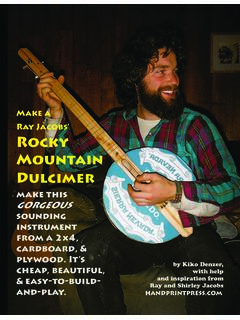Transcription of Why DoThey Keep Digging UpThe Past? - Mountain …
1 Why Do They Written by Mary Meehan Photography by Lance C. BellKeep Digging Up The Past? Susquehanna Indian painting by Lee Teter. The Susquehannock and Shawnee tribes were among the residents who lived here along the Potomac Roy Brown scraping soil from one of the excavation pits at the June 2007 for artifact in a quarter inch mesh m o u n t a i n d i s c o v e r i e s AS A BOY GROWING UP IN RAWLINGS, MD, GARY GRANT HUNTED FOR ARROWHEADS ON THE JOHN BARTON FARM. Finding his first arrow-head made him ask, Okay, who made this?
2 How did they make it? While accounting became Grant s profession as an adult, archeology is his delight. Besides reading and taking courses in it, he has participated in digs in Colorado, West Virginia, and all over the State of Maryland. Thirty acres of the old Barton Farm are now the Barton Site, an archeological dig on Route 220, south of Cumber-land. Grant and other volunteers now work there under the supervision of Dr. Robert Wall, an archeologist who teaches at Towson University, Towson, Md. They re Digging into the story of American Indians who lived along the Potomac River from 12,000 or more years ago through the arrival of English settlers in the 1700s Members of the Susque-hannock and Shawnee tribes were among later The Western Maryland chapter of the Archeological Society of Maryland provides major support for work at the Barton Site.
3 Ed Hanna, a retired police officer who heads the chapter, notes that there are ancient sites every-where in Western Maryland. Most are in or near valleys and rivers, which Hanna calls the interstates of ancient times. The Barton site, on a Potomac River flood plain, was the location of many successive settlements, and silt deposits from flooding sealed off one era from another. This stratification aids archeological understanding, so Barton is a prime site. Now owned by the Archaeological Conservancy, a New Mexico-based group, the site has been excavated since the late 1980s by volunteers working with Dr.
4 Of the Brown (kneeling) prepares archeological features for photographs by Dr. Robert Wall (left, standing).m o u n t a i n d i s c o v e r i e s 31 Freelance collection of arrowheads is no longer allowed on the property. Instead, the volunteers work together to find artifacts and old building sites and to explain how the old residents lived. As Gary Grant says, their life is a fascinating puzzle that needs to be put together. Dr. Wall, who already has a huge amount of data from prior work at the site, uses that and surveying equipment to map out areas to be excavated in the summer months.
5 Each excavation pit is large enough for one or two people sometimes more to work in; and fi ve or more pits may be worked simultaneously when there are enough volunteers. One day last June, Ed Hanna s pit was about 16 inches deep, and he was already back to the 1600s. Others were working on a deep unit that was expected to go down about eight feet and possibly as far back as 15,000 some volunteers scrape soil from the pits, others run it through large sifters that are suspended from tripods. Standing at the sifters, they push the dirt through and watch carefully for bone beads, stone scrapers and awls, pieces of pottery, and points.
6 The latter are small, triangular stones that the Indians cut and sharpened for use as knives, spear points, or Bob Bantz, working one of the large sifters, watches for beads, scrapers, pottery and pendant and a bone bead found at the site in June trade bead from early contact with Frederick points our traces of an 1800s settler s plow and 1600s Native American post m o u n t a i n d i s c o v e r i e s m o u n t a i n d i s c o v e r i e s 33m o u n t a i n d i s c o v e r i e s 33 Andrew Barnhart, a high school student from Hagerstown, Md.
7 , was one of the sifters in June. He said he found the work a lot harder than what I expected, but he enjoyed fi nding a couple of beads, a couple of points. He is considering a career in are several Towson University students who were working at the site as part of an archeology course for which they ll receive academic credit. Leah Singleton said she was just baking in the summer sun and that her muscles ached by the end of each day. I m like, wow, I haven t talked to that muscle in a long time, she laughed.
8 She had found only bones and points in her fi rst days of sifting, but was glad that others had found more interesting items a stone awl, for example. Sharon Rossman, another Towson student, wants to be a forensic anthropologist. She was happy to find a bone bead and a few points. While she liked the summer heat, she acknowledged some boredom in just sifting. But when volunteers had time to look up or walk around, they had striking views: West Virginia s Knobly Mountain on the southeast, farm country to the south, and Maryland s majestic Dans Mountain to the west.
9 The people who lived there thousands of years ago must have enjoyed their magnifi cent valley. David Frederick had graduated to working in a pit, carefully scraping the surface and watching for evidence of primitive buildings. Frederick, who grew up in Cumberland and now lives in nearby Keyser, , was using up his vacation to help with the dig. A maintenance supervisor at a saw mill, he said many people think he s crazy to work in a hot fi eld as a volunteer during his vacation. But he added, I m getting paid.
10 Not in money, but in knowledge. He thinks often about the ancient people who lived at the Barton Site and how hard a life they had here. And I just imagine trying to do things with stone tools and not being able to go down to the hard-ware store and buy what you need. It s believed that the bow and arrow were invented around 1000 Without them, Frederick said, hunters had only knives and spears to kill deer, elk, and bear. That made hunting both diffi cult and dangerous. Or, as Ed Hanna remarked, one can imagine a hunter s trying to get dinner before dinner gets him.






